In terms of the amount of electricity that can be generated from the solar irradiation falling on each square meter of land or water, Taiwan’s southwest is one the most promising regions in East Asia.
Despite setting ambitious renewable-energy goals, the government isn’t willing to compel factory bosses and real-estate developers to install photovoltaic (PV) arrays on every suitable roof. Efforts to unlock the country’s solar-power potential have therefore focused on putting panels on schools and other public buildings, while offering incentives to property owners. South of Taichung, PV systems atop chicken coops, pigpens and warehouses are now a common sight. At the same time, a growing number of farmers are accepting subsidies to convert their fields into solar power plants.
The environmental ramifications of covering farmland with PV arrays aren’t as bad as sealing it beneath concrete. But any shift away from growing crops makes it less likely Taiwan will achieve a target set in 2011, and reiterated earlier this year by President Tsai Ing-wen (蔡英文), of boosting the country’s food self-sufficiency rate to 40 percent.
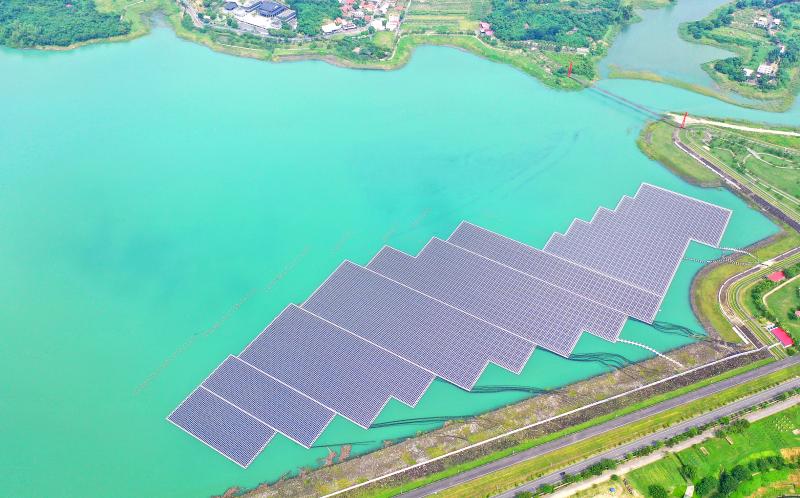
Photo courtesy of Ciel et Terre
In these circumstances, it’s hardly surprising that solar-energy entrepreneurs have turned their attention to ponds and fish farms. Floating photovoltaic (FPV) plants have proliferated since 2017, when a system on Agongdian Reservoir (阿公店水庫) in Kaohsiung began supplying Taipower.
The setup at Agongdian — which comprises 34,013 electricity-producing panels — is equipped with technology owned by Ciel et Terre, a French floating solar solution supplier and developer of large-scale FPV plants.
According to Hannah Wang (王詩涵), a senior saleswoman at Ciel et Terre’s Taiwan branch office, the system’s floats are manufactured in Taiwan of high-density polyethylene (HDPE), a plastic polymer that is 100 percent recyclable.
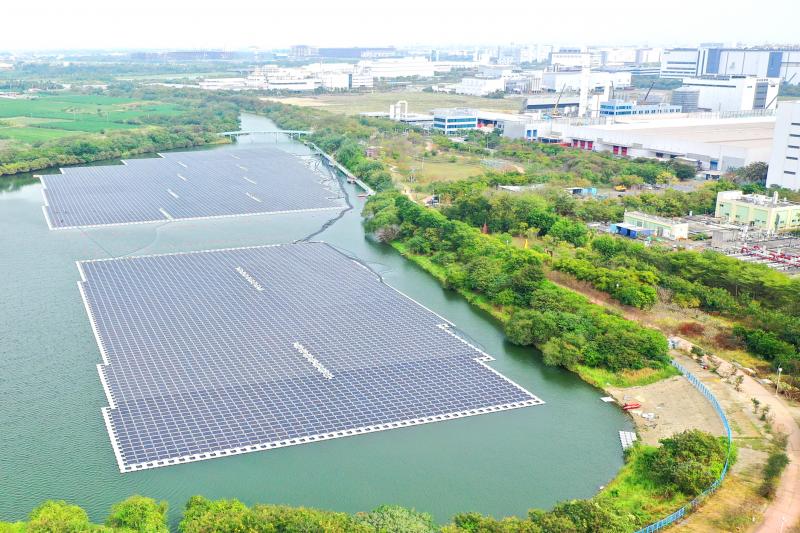
Photo courtesy of Ciel et Terre
Wang says Ciel et Terre technology can resist UV degradation for at least 25 years, and that all their products meet drinking-water standards set by the UK and other countries.
Responding to concerns that FPV arrays could affect water quality, a press release issued by Tainan City Government on Dec. 5 last year reassures residents that the floats are able to withstand UV radiation, water that’s unusually acidic or alkaline, and will neither oxidize nor dissolve. Using chemicals to clean the panels is prohibited.
Equipment, installation and maintenance costs for FPV are often 10 percent higher than for land or roof-based systems. However, these may be partly offset by more generous feed-in tariffs (FITs, the prices at which Taipower promises to buy electricity for 20 years following a system’s installation). Governments throughout the world use FITs to encourage investment in renewable energy.
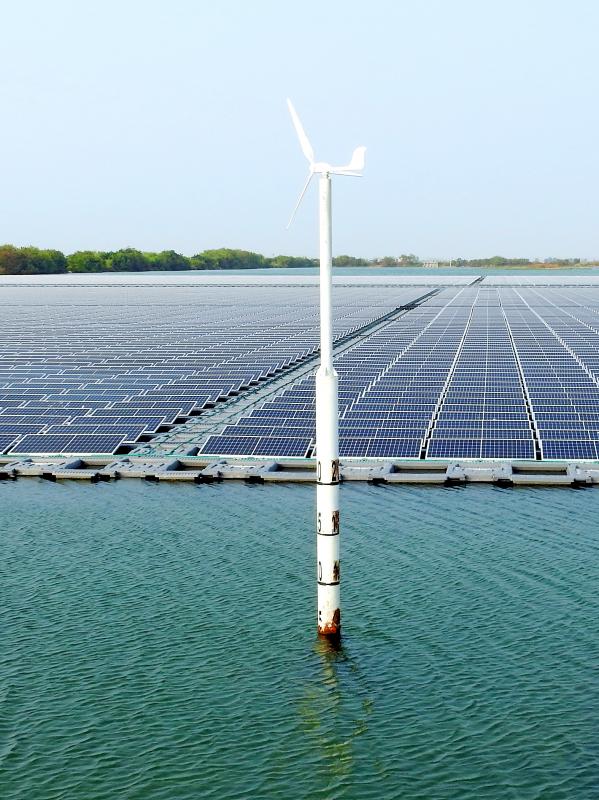
Photo: Steven Crook
In the second half of this year, Taipower’s basic FIT for FPV is NT$4.2709 per kWh. For ground-mounted systems, it’s NT$3.8752. For roof-mounted systems, the tariff varies from NT$5.7132 (for small arrays) to NT$3.9917. To make up for the north being less sunny, FITs for any type of solar power there are marked up 15 percent.
In warmer locations, FPV has two inherent advantages over roof- or ground-mounted systems. First, panels over water benefit from additional diffuse irradiation from water-surface reflections. Second, PV panels become less efficient in high temperatures, but this is mitigated by the cooling effect of the body of water. Some FPV advocates say these two factors can boost performance by as much as 10 percent.
FPV may bring environmental benefits beyond the generation of clean power. By reducing evaporation, large-scale floating systems could help conserve valuable freshwater. According to the Water Resources Agency, about 24 percent of the rain that falls on Taiwan is lost to evaporation. However, it’s possible that less evaporation would result in less precipitation.
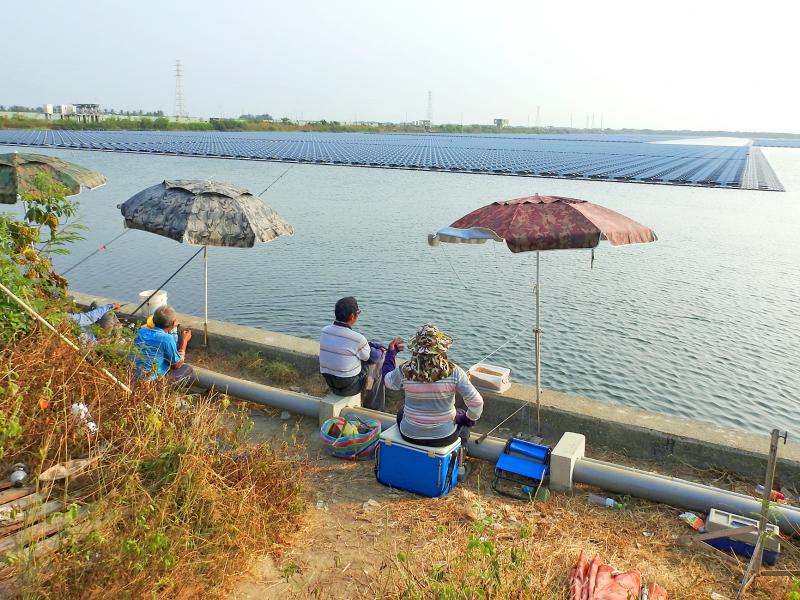
Photo: Steven Crook
If less sunshine hits the surface of the pond or reservoir, the water temperature may fall. The ecological consequences of this are hard to predict.
Some researchers suggest that, by reducing the amount of sunlight penetrating the water, FPV can improve water quality by inhibiting the growth of algae and limiting the conversion of bromide into bromate, a suspected human carcinogen.
At the same time, less algae means less food for certain insect and fish species, potentially upsetting the aquatic food chain. Obstruction is another issue.
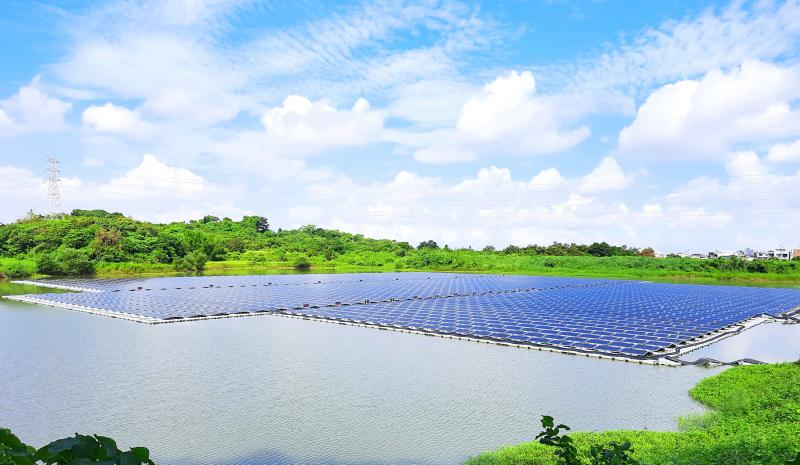
Photo: Steven Crook
“I’ve not seen any studies about this, but I’d assume that solar panels on top of a pond would definitely create difficulties for birds when they’re foraging,” says Victor Yu (余維道), president of Ecotourism Taiwan.
Within the FPV industry, birds are often seen as irritants. Baked-on bird droppings can etch the surface of panels and permanently reduce their efficiency. Some FPV owners in Europe have resorted to using lasers and other technologies to keep birds away.
Whether they’re floating, roof-mounted, or ground-mounted, PV systems in Taiwan must be able to withstand typhoons.
“The mooring for floating PV systems requires careful design and engineering. You don’t want an incident like the one in Japan last year,” says Lin Fen-yu (林芬玉), a project coordinator at Blue21, a Dutch company that designs and engineers floating urban projects. She refers to damage suffered by a FPV system at Yamakura Dam, not far from Tokyo, when typhoon winds ripped an array apart. Modules got stacked on each other, overheated and caught fire.
According to Lin, new technology in the pipeline would make it possible for an entire PV system to submerge when a storm approaches, then resurface after it’s passed.
“There’s definitely a lot of interest in FPV in Taiwan, and it’s a big market. In recent years, we’ve noticed an increasing number of patent applications from Taiwanese research institutes and companies for FPV innovations,” she says. “There are lots of suitable inland water bodies around the world, but the really big slice of pie is the offshore environment.”
Even in regions where typhoons aren’t a threat, however, building reliable maritime PV systems is challenging.
Vienna-based Swimsol GmbH, which has focused on FPV for marine environments since 2012, has developed corrosion-proof components made of high-grade aluminium and UV-resistant plastics, says managing director Martin Putschek. To reduce the stress on its platforms, the company has devised a float with a wireframe design that ensures just a small part comes into contact with waves.
“They pass through it without releasing their full force on impact,” says Putschek. “As our technology advances, markets like Taiwan or Japan could become interesting.”
Ciel et Terre has been dealing with similar issues at Taiwan’s largest FPV project, which occupies part of a rectangular cove between Changbin Industrial Zone (彰濱工業區) and Lunwei (崙尾) in Changhua County’s Lukang Township. The French company is supplying the floats and the system which fixes the PV panels to the floats.
“It may be the most challenging project we’ve encountered in Taiwan so far. Because it’s on an intertidal zone with seawater, we need to take great care to avoid rusting. Also, the capacity of this project is 88 mW [nine times’ that of the plant at Agongdian], so quality control and the delivery schedule are key for our client, which expects grid-connection at the end of this year,” says Ciel et Terre’s Wang.
Asked if freshwater will have to be transported to the cove to clean the solar panels, Wang says that for FPV arrays on freshwater, filtered pond water is often good enough, but that “this method isn’t suitable for saltwater, and we don’t know how our client will solve this problem.”
One feature of the Changbin FPV plant has come in for criticism. When the tide goes out, part of the vast array settles on the silt, which surely isn’t good for the crabs and other creatures that inhabit the mudflats. An environmentalist who took drone photos, and shared them on social media under the name Drifting Island (漂浪島嶼), exclaimed: “It is no exaggeration to say the ground has been tiled over!”
Wang claims that the shape of Ciel et Terre’s floats ensures there’s no paving effect.
On July 2, 2020, the United Daily News reported that, because the location has long been classified by the government as an industrial zone, rather than an intertidal zone, no environmental impact assessment has been required since the one completed more than 30 years ago, long before Taiwan embraced solar energy.
Blue21’s Lin isn’t familiar with the Changbin project, but says: “All over the world, the ecological impact of floating PV solar has been overlooked. This is a serious issue, and it should be addressed ASAP.”
Steven Crook, the author or co-author of four books about Taiwan, has been following environmental issues since he arrived in the country in 1991. He drives a hybrid and carries his own chopsticks.

Under pressure, President William Lai (賴清德) has enacted his first cabinet reshuffle. Whether it will be enough to staunch the bleeding remains to be seen. Cabinet members in the Executive Yuan almost always end up as sacrificial lambs, especially those appointed early in a president’s term. When presidents are under pressure, the cabinet is reshuffled. This is not unique to any party or president; this is the custom. This is the case in many democracies, especially parliamentary ones. In Taiwan, constitutionally the president presides over the heads of the five branches of government, each of which is confusingly translated as “president”

By 1971, heroin and opium use among US troops fighting in Vietnam had reached epidemic proportions, with 42 percent of American servicemen saying they’d tried opioids at least once and around 20 percent claiming some level of addiction, according to the US Department of Defense. Though heroin use by US troops has been little discussed in the context of Taiwan, these and other drugs — produced in part by rogue Chinese Nationalist Party (KMT) armies then in Thailand and Myanmar — also spread to US military bases on the island, where soldiers were often stoned or high. American military policeman

An attempt to promote friendship between Japan and countries in Africa has transformed into a xenophobic row about migration after inaccurate media reports suggested the scheme would lead to a “flood of immigrants.” The controversy erupted after the Japan International Cooperation Agency, or JICA, said this month it had designated four Japanese cities as “Africa hometowns” for partner countries in Africa: Mozambique, Nigeria, Ghana and Tanzania. The program, announced at the end of an international conference on African development in Yokohama, will involve personnel exchanges and events to foster closer ties between the four regional Japanese cities — Imabari, Kisarazu, Sanjo and

The Venice Film Festival kicked off with the world premiere of Paolo Sorrentino’s La Grazia Wednesday night on the Lido. The opening ceremony of the festival also saw Francis Ford Coppola presenting filmmaker Werner Herzog with a lifetime achievement prize. The 82nd edition of the glamorous international film festival is playing host to many Hollywood stars, including George Clooney, Julia Roberts and Dwayne Johnson, and famed auteurs, from Guillermo del Toro to Kathryn Bigelow, who all have films debuting over the next 10 days. The conflict in Gaza has also already been an everpresent topic both outside the festival’s walls, where